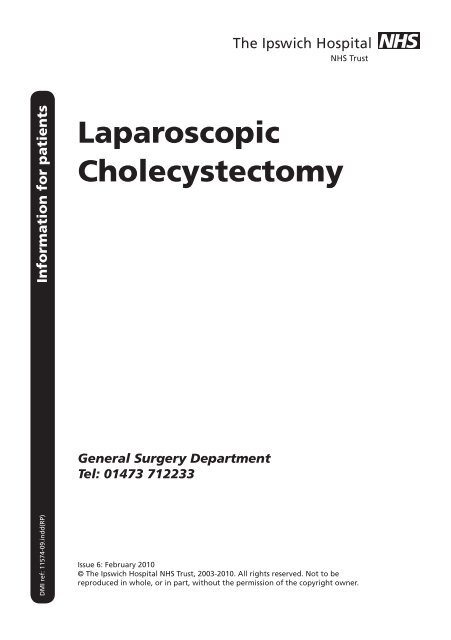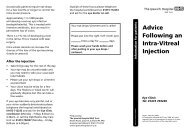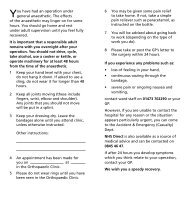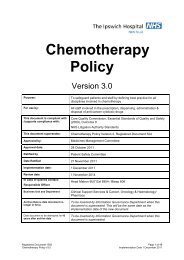Laparoscopic Cholecystectomy - Ipswich Hospital
Laparoscopic Cholecystectomy - Ipswich Hospital
Laparoscopic Cholecystectomy - Ipswich Hospital
You also want an ePaper? Increase the reach of your titles
YUMPU automatically turns print PDFs into web optimized ePapers that Google loves.
Information for patients<br />
<strong>Laparoscopic</strong><br />
<strong>Cholecystectomy</strong><br />
General Surgery Department<br />
Tel: 01473 712233<br />
DMI ref: 11574-09.indd(RP)<br />
Issue 6: February 2010<br />
© The <strong>Ipswich</strong> <strong>Hospital</strong> NHS Trust, 2003-2010. All rights reserved. Not to be<br />
reproduced in whole, or in part, without the permission of the copyright owner.
Introduction<br />
<strong>Laparoscopic</strong> cholecystectomy is an operation to remove the gall<br />
bladder using keyhole surgical techniques.<br />
What is the gall bladder?<br />
Your liver has many functions, one of which is to produce a substance<br />
called bile. This green liquid drains from the liver to the intestine via<br />
the bile duct (see diagram below). The gall bladder is a small reservoir<br />
attached to the side of the bile duct where bile can be stored and<br />
concentrated between meals. When we eat, particularly fatty foods,<br />
the gall bladder contracts and empties extra bile into the bile duct and<br />
then into the intestine to mix with the food. Bile has many functions,<br />
one of which is to allow us to absorb fat. The gall bladder sits just<br />
under the liver, which is in the right upper part of the abdomen, just<br />
under the ribs.<br />
liver<br />
stones in<br />
gall bladder<br />
intestine<br />
cystic duct<br />
pancreas<br />
common<br />
bile duct<br />
pancreatic<br />
duct<br />
Page 3
Why might I need my gall bladder removed?<br />
Usually this is because it is giving you pain due to gallstones. These<br />
small stones form in the gall bladder and can cause a range of<br />
problems including pain, jaundice, infection and pancreatitis. They are<br />
very common but do not always cause symptoms. Gallstones that are<br />
not causing trouble can usually be left alone.<br />
How is a laparoscopic cholecystectomy different from<br />
the traditional operation for gall bladder problems?<br />
Traditionally, we make a small cut underneath the ribs 10 – 15 cm long.<br />
The laparoscopic (keyhole) operation differs only in the way in which<br />
we get to the gall bladder to remove it – through four very small cuts.<br />
The traditional method takes longer to heal than the four little holes<br />
of keyhole surgery and the recovery is slower.<br />
Is there a guarantee that keyhole surgery can be<br />
done?<br />
No, there is no guarantee that the operation can be completed by<br />
keyhole surgery. If there is some technical difficulty with removing<br />
the gall bladder then a traditional cut would be needed to remove it.<br />
The time in hospital would be a little longer (about 3 – 5 days) and the<br />
recovery at home would be 6 – 8 weeks. The risk of having to convert<br />
to open surgery is small, about 1 – 3%.<br />
Is there an alternative to surgery for gallstones?<br />
Unfortunately no alternative exists. The only successful treatment is to<br />
remove the gall bladder and gallstones completely. The results of this<br />
operation are very good and most patients can then return to eating a<br />
normal diet.<br />
Can I manage without my gall bladder?<br />
Yes. The gall bladder is a reservoir for bile and we are able to manage<br />
without it. Rarely, patients notice that their bowels are a little looser<br />
than before the operation, but this is uncommon.<br />
Page 4
You will be able to eat a normal diet after your operation, assuming<br />
that there is nothing else wrong with you.<br />
Are there any risks?<br />
Removal of the gall bladder is a very common and a very safe<br />
procedure. However, like all operations there are small risks involved.<br />
We believe that it is very important that you are fully aware of these<br />
risks as this affects your understanding of what the operation involves.<br />
The possible complications below are particularly important as they<br />
can mean that you need to stay in hospital for longer and that further<br />
operations or procedures are required.<br />
Bleeding<br />
This very rarely occurs after any type of operation. Your pulse and<br />
blood pressure are closely monitored after your operation as this<br />
is the best way of detecting this potential problem. If bleeding is<br />
thought to be happening, you will require a further operation to stop<br />
it. This can usually be done through the same keyhole scars as your<br />
first operation.<br />
Infection<br />
This can affect your scars (‘wound infection’) or can occur inside<br />
your abdomen. Again this can happen after any type of abdominal<br />
operation. Simple wound infections can be easily treated with a short<br />
course of antibiotics. Infection inside your abdomen will also usually<br />
settle with antibiotics. Occasionally, it may be necessary to drain off<br />
infected fluid from inside your abdomen. This is most frequently<br />
performed under a local anaesthetic in the X-ray Department.<br />
Leakage of bile<br />
When we remove the gall bladder, we put special clips on the tube<br />
that connects the gall bladder to the main bile duct draining the liver.<br />
Despite this, bile fluid sometimes leaks out. If this does occur, we have<br />
a number of different ways of dealing with this. Sometimes the fluid<br />
can simply be drained off in the X-ray Department.<br />
In other cases we will ask some other colleagues to perform a special<br />
test called an ERCP. This is a procedure where you are made very<br />
Page 5
sleepy (using sedative injections) and a special flexible camera (‘an<br />
endoscope’) is passed down your oesophagus (gullet) and stomach to<br />
allow the doctor to see the lower end of your bile duct. The doctor<br />
then injects a special dye that allows them to see where the bile has<br />
leaked from. If they see where the bile is leaking from, they will insert<br />
a plastic tube (called a stent) into your bile duct to allow the bile to<br />
drain internally. This stent is usually removed 6 – 8 weeks after it is put<br />
in.<br />
Rarely, if a patient develops a bile leak, an operation is required to<br />
drain the bile and wash out the inside of the abdominal cavity. This<br />
can usually be performed as a keyhole procedure.<br />
Injury to the bile duct<br />
Injury to the main bile duct draining bile from the liver to your<br />
intestine is a rare (1 in 400 cases) complication of gall bladder surgery.<br />
We use a number of techniques during the operation to prevent this<br />
happening. If an injury occurs, it requires immediate repair so that you<br />
recover smoothly from the operation. Repair of this injury requires an<br />
open cut to be made under your ribs.<br />
Injury to intestine, bowel or blood vessels<br />
Injury to these structures can, very rarely, occur during the insertion<br />
of the keyhole instruments and during the freeing up of the gall<br />
bladder particularly if it is very inflamed. Usually this injury can be<br />
seen and repaired at the time of the operation, but occasionally may<br />
only become clear in the early postoperative period. If we suspect that<br />
you may have sustained such an injury, a further operation will be<br />
required. This will be performed as a keyhole operation but will need<br />
conversion to an open operation if necessary.<br />
Blood clots in the legs (DVT)<br />
Before your operation, you will be fitted with some stockings that you<br />
wear during your operation to help prevent blood clots developing in<br />
the veins of your legs. You may also be given an injection in the skin<br />
of your abdomen – this is a blood-thinning drug (heparin) that also<br />
helps prevent blood clots.<br />
Page 6
Before your operation<br />
You will attend a pre-admission clinic, where you will be seen by a<br />
member of the team who will be looking after you in hospital.<br />
When you attend the outpatient clinic, you will be informed by the<br />
doctor you see about where your operation will be carried out. In<br />
particular, we will discuss how long you will need to stay in hospital<br />
after your operation.<br />
At this clinic, we will ask you for details of your medical history and<br />
carry out a physical examination. We will arrange any investigations<br />
and tests you require. This is a good opportunity for you to ask us any<br />
questions about the procedure, but please feel free to discuss any<br />
concerns you might have at any time.<br />
You will be asked if you are taking any tablets or other types of<br />
medication – these might be ones prescribed by a doctor or bought<br />
over the counter in a pharmacy. It helps us if you bring details, or the<br />
packaging, with you of anything you are taking.<br />
The majority of gall bladder operations we perform are now carried<br />
out as day cases although this may not be suitable for everyone.<br />
Whether your procedure will be carried out as a day case or not,<br />
you will almost always be admitted to hospital on the day of your<br />
operation.<br />
Before your operation your anaesthetist will visit you on the ward.<br />
They will review your medical history. In particular, you will be asked<br />
about your medications and any health problems that you have.<br />
They will also ask you about previous anaesthetics you have had and<br />
whether you had any problems with these (for example, nausea).<br />
You will be asked if you are allergic to anything. They will also want<br />
to know about your teeth, whether you wear dentures, have caps<br />
(crowns) or a plate. Your anaesthetist may examine your heart and<br />
lungs.<br />
Occasionally you may be prescribed medication that you will be given<br />
shortly before your operation – this is known as the ‘pre-medication’<br />
or ‘pre-med’. It relaxes you and may send you to sleep.<br />
Page 7
During the operation itself<br />
Before your procedure, you will be given a general anaesthetic. This is<br />
usually performed by giving you an injection of medication into a vein<br />
through a small plastic tube, usually placed in your arm or hand.<br />
While you are unconscious and unaware, your anaesthetist remains<br />
with you at all times, monitoring your condition and controlling<br />
your anaesthetic. At the end of the operation, your anaesthetist<br />
will reverse the anaesthetic and you will regain awareness and<br />
consciousness in the recovery room, or as you leave the operating<br />
theatre.<br />
Four small holes (about 1 cm long each) are made in the abdominal<br />
(tummy) wall. Through these, we inflate your abdomen with carbon<br />
dioxide gas which is completely harmless.<br />
We then use special long instruments to free up the gall bladder,<br />
with its stones, from underneath the liver, and it is completely<br />
removed. This is all displayed on a TV screen by a miniature camera<br />
inserted through one of the four keyholes. In addition, it is sometimes<br />
necessary to perform a special x-ray during the operation called a<br />
cholangiogram. This is used to check for stones in the bile duct.<br />
At the end of the operation, before you wake up, all the puncture<br />
sites in your abdomen will be treated with local anaesthetic so that<br />
when you first wake up there should be very little pain. Some patients<br />
have some discomfort in their shoulders, but this wears off quite<br />
quickly.<br />
The wounds will be covered with small waterproof dressings.<br />
Page 8
After the operation<br />
You will wake up in the recovery room after your operation. You<br />
might have an oxygen mask on your face to help you breathe. You<br />
might also wake up feeling sleepy.<br />
After this procedure, you will probably have a thin, plastic tube in<br />
one of the veins of your arm. This might be attached to a bag of fluid<br />
(called a drip), which feeds your body with fluid until you are well<br />
enough to eat and drink by yourself.<br />
While you are in the recovery room, a nurse will check your pulse and<br />
blood pressure regularly. When you are well enough to be moved, you<br />
will be taken to a ward.<br />
Sometimes, people feel sick after an operation, especially after<br />
a general anaesthetic, and might vomit. If you feel sick, please<br />
tell a nurse and you will be offered medicine to make you more<br />
comfortable.<br />
Eating and drinking<br />
You will be able to drink immediately after the operation and if this is<br />
all right and you do not feel sick, you will be able to eat something.<br />
Getting up and about<br />
After your operation, you can get up and about as soon as you feel<br />
comfortable.<br />
Going home<br />
Most patients will go home the same day as their operation. You will<br />
be reviewed by the doctors and nursing staff on the ward after your<br />
operation. You will be allowed home after you have had something<br />
to drink and eat. We will also check that you are not feeling sick and<br />
have been able to pass urine. You will be given a supply of simple pain<br />
relief medication to take home. We recommend that you take these<br />
regularly for the first couple of days at home after your operation.<br />
Page 9
You may feel discomfort for 7 – 10 days, but simple pain relief tablets<br />
are usually all that people need to enable them to be fully mobile at<br />
home.<br />
Going back to work<br />
We expect you to return to normal activities in a matter of days<br />
following your procedure. You can drive again when you can<br />
comfortably make an emergency stop (generally about seven days, but<br />
this must be checked in a stationary car first!). Other more vigorous<br />
activities can be resumed after two weeks if you feel comfortable.<br />
Wound care<br />
All the wounds are closed with dissolvable stitches under the skin and<br />
therefore nothing needs to be done to these after the operation.<br />
The wounds are covered with small waterproof dressings which we<br />
ask you to keep intact for five days if possible. They are showerproof<br />
but will come off in a hot bath. We suggest that you get into a hot<br />
bath on day five, gently remove the dressings and leave the wounds<br />
open to the air. If they rub on your clothing you may find it more<br />
comfortable to put a small Elastoplast-type dressing over each wound.<br />
If you have any worries about your wounds, you should contact your<br />
GP.<br />
Follow-up and results<br />
Before you leave hospital you will be advised about your expected<br />
recovery. We do not need to see you routinely for a check up in the<br />
clinic but are always happy to do so if you have any problems.<br />
Page 10
Produced by:<br />
The <strong>Ipswich</strong> <strong>Hospital</strong> NHS Trust<br />
Heath Road, <strong>Ipswich</strong>, Suffolk IP4 5PD<br />
<strong>Hospital</strong> switchboard: 01473 712233<br />
www.ipswichhospital.nhs.uk

















